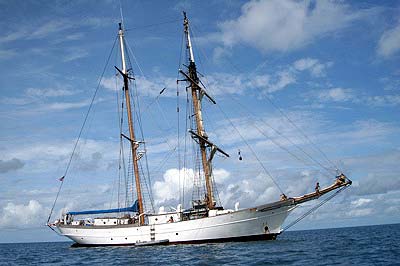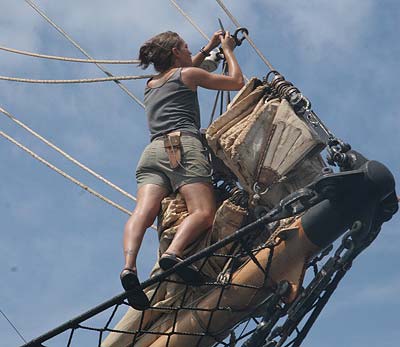Going to school at sea

12/05/2006, Tyrell Bay, Carriacou, Grenada
Our Floating Classroom Project is a virtual classroom – you’re learning about the sea and sailing by following us on the internet. Imagine, for a minute, going to school on a ship AT sea. That’s exactly what a group of 25 students are doing onboard the sea school vessel Corwith Cramer. The students attend a College in the United States, at Woods Hole, Massachussetts and as part of their course work, they go to school at sea for 6 weeks of the school year. It’s a challenging yet exciting program that enables young people (between the ages of 18 – 22 years) to develop an understanding of real scientific research at sea. They also learn firsthand the skills of being a deck hand on a traditional sailing vessel too – from scrubbing the decks to climbing the rig, washing the sails or prepping the food, you’ll find the students doing their jobs. Looking online at the Sea Education program from Woods Hole, we could see they had one of their 2 ships enroute to Carriacou in November. What luck! And that’s just where we’re located.
Sea School vessel Corwith Cramer came into view around 5:30 pm sailing past the Tyrell Bay anchorage enroute to Hillsborough just 4 nm away. They were coming in just as the sun was setting. The ship was to be in port for 2 days, where the crew were finishing a few jobs before heading to their final port of call, St. Croix in the US Virgin Islands. Through our friends Randy and Susan on sv Nancy Dawson, we were invited onboard for a tour of the ship. The Captain of the Corwith Cramer had served under Randy 20 years ago on the research vessel, Westward as she sailed around the world.
On board
We dinghied up to the 130 ft Corwith Cramer where she was anchored in Hillsborough, with her welcome mat rolled out. Onboard, we met the full-time crew, students, Chief Engineer Rick, Chief Scientist Chuck and Captain Beth. We were given the ultimate tour of the ship from stem to stern by both Chuck and Beth. We crawled around the engine room, sat in the captain’s quarters, poked our heads in the galley, toured the lab and saw a range of scientific equipment used onboard.
Kim crawling through the engine room
Talking to some of the students, we learned about their daily routines. This was no 6-week holiday cruise. The 25 students were divided into 5 teams and each team worked in shifts. On one shift, for example, one team was responsible for plotting the ship’s course using a variety of navigational aids, keeping watch, and navigating at night using an instrument called a sextant to follow a course using the stars. This is called celestial navigation. At the same time, another team would be doing food prep, while another team might be working in the engine room. In addition, the students also carried out their own research projects as part of their coursework at the school. And of course, somewhere in between, the students could catch a little sleep. The days were long, starting for some as early as 4:30 am until 11:00 pm, unless you were on watch overnight. The longest time the Corwith Cramer had been at sea on this six week expedition was 21 days. (That’s a long time not standing on solid ground). She would then go into port for a little provisioning and brief shore leave for her crew. A welcome relief I’m sure.
Speaking to both the Chief Scientist, Chuck and Captain Beth, they have been doing this work for more than 15 years. Captain Beth explained that the Sea School gives women the opportunity to become captains and encourages women to pursue their interests in sailing. Both Chuck and Beth teach at the college in Massachussetts for 6 weeks and take students out at sea for 6 weeks. The ship is their home for two 6-week blocks each year. In between their time at sea, another crew and group of students board the Corwith Cramer for adventures through the Caribbean. Some formal classwork occurs on board. Chief Scientist Chuck also conducts research underway and supervises the students with their research. The science data that are collected include core samples from the ocean’s floor, water sampling at hundreds or thousands of feet to examine water quality and living organisms. Surface pollution such as plastics are collected in nets and Chuck pointed out that there seems to be less evidence of oil pollution but more prevalence of plastics over time, particularly in the Sargasso Sea.
This is an excellent opportunity for young people interested in learning about science on the ocean and sailing. For those of us who grew up watching Jacques Cousteau’s Underwater World on television and dreaming about a life at sea, it’s reassuring to know these learning opportunities are out there. Programs like this are also available for Canadian students. West Island College’s Class Afloat program offers high school students the opportunity to spend Grade 11 and 12 at sea. This program is out of Lunenburg, Nova Scotia, home of Canada’s historic Bluenose schooner. Many thanks to the Captain and crew of Sea School vessel Corwith Cramer. As said amongst sailors, Long may your big jib draw. Fair winds and following seas, friends.




